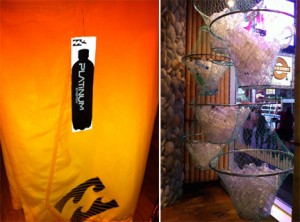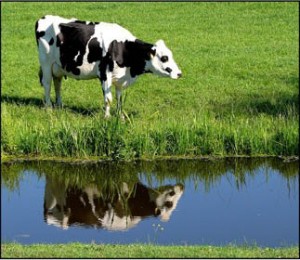 To date, Billabong has saved order 37 million plastic bottles from the ocean. What did they do with them?
To date, Billabong has saved order 37 million plastic bottles from the ocean. What did they do with them?
Chicago Doesn’t Recycle Their Drinking Water? LakeDance Brings Awareness
LakeDance is a very creative project aimed at building awareness about the Great Lakes water-related problems and helping the Great Lakes re-reverse water flow.
The Great Lakes give drinking water to 40 million people*, a critical oasis for sustained clean water supply. Remember the post about recycled water from the movie Last Call at the Oasis? Recycled drinking water is the solution to prevent a water shortage and worldwide water crisis, or “water wars”.
Chicago does not recycle their drinking water. The reason goes back to history:
Flow: Reversed. In 1900, under cover of darkness, the City of Chicago completed the digging of a controversial canal that would reverse the flow of the Chicago River to go from its natural outlet into Lake Michigan to be channeled, instead, into the newly dredged drainage canal that emptied south toward the Mississippi River and the Atlantic Ocean…. This was done to salvage Chicago’s drinking water, whose intake was perilously close to a growing river of animal carcasses and human waste! However, the controversial reversal of the river has devastating implications now as the Asian Carp move north along the Illinois River…
(source: http://kck.st/JIIsAI)
To learn more, and to help with this cause, check out the video on Kickstarter:
*Source: GreatLakes.org
How to Get Cheaper Coffee?
And save the oceans all in one? Listen up!
Many coffee shops will give you a discount if you bring in your own mug! Why? Because they love you. Well, I’m sure they do, but also you are saving them money. But, to take it to an even warmer and fuzzier level – it saves waste. Less waste saves marine life.
Participating coffee shops:
- Starbucks
- Tully’s
Save $.10 per cup (this adds up!)
Know of more coffee shops to add to this list? Let everyone know! We can get our buzz on and save a dime and a turtle at the same time.
Movie Review Last Call at the Oasis – “Cockroached Water”?
I watched the movie “Last Call at the Oasis” last night with famous activist Erin Brockovich.
 I had no idea it was opening night, I was just passing by the Landmark Sunshine theater on my way home and decided to pop in. The author of the book “The Ripple Effect”, Alex Prud’homme, was there and gave a quick talk before the movie started and I got a free copy of the soundtrack. Bonus!
I had no idea it was opening night, I was just passing by the Landmark Sunshine theater on my way home and decided to pop in. The author of the book “The Ripple Effect”, Alex Prud’homme, was there and gave a quick talk before the movie started and I got a free copy of the soundtrack. Bonus!
Some of the highlights:
- Lake Mead is declining by 10 feet per year due to our water usage
- Amphibians exposed to chemicals sprayed on crops turn into hermaphrodites
- The 10-year drought in Australia is due to climate change, in other words, it’s not temporary. Farmers are frequently taking their own lives.
- The water fountains in Vegas use 3% of the city’s water supply, despite the fact that they are running out of water.
- Of the more than 80,000 chemicals used in the United States, only 5 are regulated under the Toxic Substances Control Act
- In several countries there are already “water wars”; the US not far behind
- Erin Brockovich gets contacted more than the Environmental Protection Agency
- The Central Valley in California is in trouble. They are artificially pumping water into dry lands just to grow crops, creating a deficit
- It takes 1,800 gallons of water to product 1 pound of beef!
- $11.2 billion / year bottled water industry in US
- 45% of the bottled water sold in the US originates as tap water
I was a little surprised that they discussed the “ripple effect” and the solution to recycling water was to treat waste water – and …. to re-bottle it!
It’s ALL about marketing. They made their point. Americans fall prey to marketing, therefore why not have Jack Black drink from the “Porcelain Springs” and everyone else will do it. It works. But, if FORTY-FIVE PERCENT of bottled water is currently coming from tap water, why do we even have bottled water? 2 million plastics bottles are consumed in the US every five minutes, causing plastic toxins to be released in our bodies and in our oceans, and in turn, our fish.
Talk about the ripple effect! I looked for Alex after the film but he had already gone.
Less than 1% of the water in the world is potable, and desalination of salt water is too expensive. There are already 14,000 desalination plants in the world (wow!). Are plastic bottles okay because it’s the oceans we are polluting?
Obviously, our drinking water isn’t currently safe, bottled or not – not sure if the title of this article is what bothers me most “Debating How Much Weed Killer Is Safe in Your Water Glass” (What do you mean how much?) or the fact that they called it a “gender bender”.
I’m contacting Erin Brockovich.
Presentation Plastics in Ocean at Gnomedex (Seattle Interactive Conference) 2011
Lifecycle of a Plastic Soda Bottle
Think twice before you consume. It’s true – plastic bottles are ubiquitous. But that doesn’t mean that they are a good idea.
Plastic bottles end up in our oceans, leaking out toxic chemicals, and breaking down into tiny pieces – that we consume! How does your bottle taste?
Watch this video!
Education from High School Students
Ozaukee High School, Fredonia, WI doing their part to reduce plastic waste.
Dear Keurig, You are Done!
Project Kaisei (kai-say) raised $1.7 million and is headed to the Pacific Ocean to educate consumers about the presence of and the associated dangers of plastics in our oceans.
Follow them on Twitter @projectkaisei or go to their website projectkaisei.org
Video of Plastic Island - the largest Garbage Dump, in the Pacific Ocean. Thank you Fresh & Co for sharing this video and for working with companies like Bottle Box to do your part to use non-petroleum based plastics.